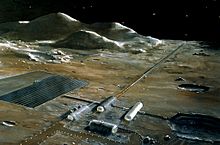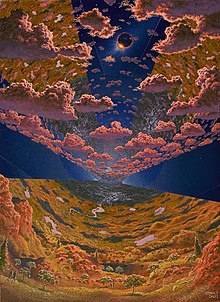


The O'Neill cylinder (also called an O'Neill colony) is a space settlement design proposed by American physicist Gerard K. O'Neill in his 1976 book The High Frontier: Human Colonies in Space.[1] O'Neill proposed the colonization of space for the 21st century, using materials extracted from the Moon and later from asteroids.[2]
An O'Neill cylinder would consist of two counter-rotating cylinders. The cylinders would rotate in opposite directions in order to cancel out any gyroscopic effects that would otherwise make it difficult to keep them aimed toward the Sun. Each would be 5 miles (8.0 km) in diameter and 20 miles (32 km) long, connected at each end by a rod via a bearing system. They would rotate so as to provide artificial gravity via centrifugal force on their inner surfaces.[1]

While teaching undergraduate physicsatPrinceton University, O'Neill set his students the task of designing large structures in outer space, with the intent of showing that living in space could be desirable. Several of the designs were able to provide volumes large enough to be suitable for human habitation. This cooperative result inspired the idea of the cylinder, and was first published by O'Neill in a September 1974 article of Physics Today.[3]
O'Neill's project was not completely without precedent. In 1954, the German scientist Hermann Oberth described the use of gigantic habitable cylinders for space travel in his book Menschen im Weltraum – Neue Projekte für Raketen- und Raumfahrt ("People in space – New projects for rockets and space travel").
O'Neill created three reference designs, nicknamed "islands":
Island One is a rotating sphere measuring one mile in circumference (1,681 feet or 512.27 meters in diameter), with people living on the equatorial region (see Bernal sphere). A later NASA/Ames study at Stanford University developed an alternate version of Island One: the Stanford torus, a toroidal shape 1,600 metres (5,200 ft) in diameter.[4]
Island Two is also spherical in design, and is also 1,600 meters in diameter.[citation needed]
The Island Three design, better known as the O'Neill cylinder, consists of two counter-rotating cylinders, each five miles (8 km) in diameter, and capable of scaling up to twenty miles (32 km) long.[5] Each cylinder has six equal-area stripes that run the length of the cylinder; three are transparent windows, three are habitable "land" surfaces. Furthermore, an outer agricultural ring, 10 miles (16 km) in radius, rotates at a different speed to support farming. The habitat's industrial manufacturing block is located in the middle, to allow for minimized gravity for some manufacturing processes.

To save the immense cost of rocketing the materials from Earth, these habitats would be built with materials launched into space from the Moon with a magnetic mass driver.[1]

The cylinders rotate to provide artificial gravity on their inner surface. Due to their very large radii, the habitats would have to rotate only about forty times an hour to simulate a standard Earth gravity. Research on human factors in rotating reference frames[6][7][8][9][10] indicate that, at such low rotation speeds, almost no-one would experience motion sickness due to coriolis forces acting on the inner ear. People would be able to detect spinward and antispinward directions by turning their heads, and any dropped items would appear to be deflected by a few centimetres.[9] The central axis of the habitat would be a zero-gravity region, and it was envisaged that recreational facilities could be located there.
The habitat was planned to have oxygen at partial pressures roughly similar to terrestrial air, 20% of the Earth's sea-level air pressure. Nitrogen would also be included to add a further 30% of the Earth's pressure. This half-pressure atmosphere would save gas and reduce the needed strength and thickness of the habitat walls.[1][4]

At this scale, the air within the cylinder and the shell of the cylinder provide adequate shielding against cosmic rays.[1] The internal volume of an O'Neill cylinder is great enough to support its own small weather systems, which may be manipulated by altering the internal atmospheric composition or the amount of reflected sunlight.[5]
Large mirrors are hinged at the back of each stripe of window. The unhinged edge of the windows points toward the Sun. The purpose of the mirrors is to reflect sunlight into the cylinders through the windows. Night is simulated by opening the mirrors, letting the window view empty space; this also permits heat to radiate to space. During the day, the reflected Sun appears to move as the mirrors move, creating a natural progression of Sun angles. Although not visible to the naked eye, the Sun's image might be observed to rotate due to the cylinder's rotation. The light reflected from the mirrors is polarized, which might confuse pollinating bees.[1]
To permit light to enter the habitat, large windows run the length of the cylinder.[1] These would not be single panes, but would be made up of many small sections, to prevent catastrophic damage, and so the aluminum or steel window frames can take most of the stresses of the air pressure of the habitat.[1] Occasionally a meteorite might break one of these panes. This would cause some loss of the atmosphere, but calculations showed that this would not be an emergency, due to the very large volume of the habitat.[1]
The habitat and its mirrors must be perpetually aimed at the Sun to collect solar energy and light the habitat's interior. O'Neill and his students carefully worked out a method of continuously turning the colony 360 degrees per orbit without using rockets (which would shed reaction mass).[1] First, the pair of habitats can be rolled by operating the cylinders as momentum wheels. If one habitat's rotation is slightly off, the two cylinders will rotate about each other. Once the plane formed by the two axes of rotation is perpendicular in the roll axis to the orbit, then the pair of cylinders can be yawed to aim at the Sun by exerting a force between the two sunward bearings. Pushing the cylinders away from each other will cause both cylinders to gyroscopically precess, and the system will yaw in one direction, while pushing them towards each other will cause yaw in the other direction. The counter-rotating habitats have no net gyroscopic effect, and so this slight precession can continue throughout the habitat's orbit, keeping it aimed at the Sun.
|
| |||||||||
|---|---|---|---|---|---|---|---|---|---|
| |||||||||
| Current |
| ||||||||
| Past |
| ||||||||
| Canceled |
| ||||||||
| In development |
| ||||||||
| Proposed |
| ||||||||
| Concepts |
| ||||||||
| Related |
| ||||||||
Notes: † Never inhabited due to launch or on-orbit failure, ‡ Part of the Almaz military program, ° Never inhabited, lacks docking mechanism. | |||||||||